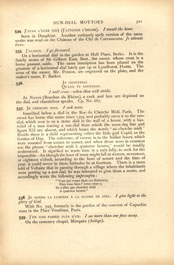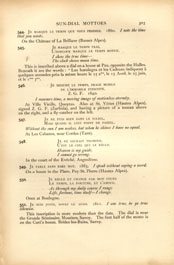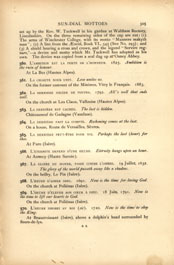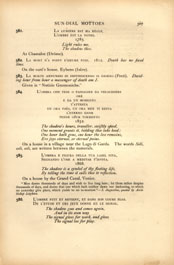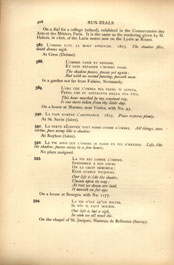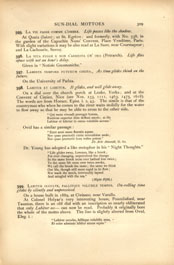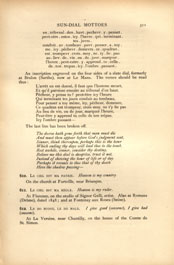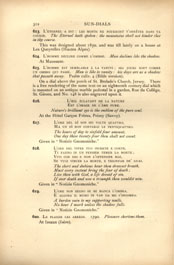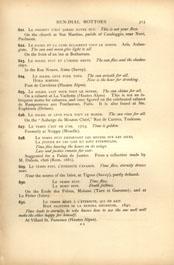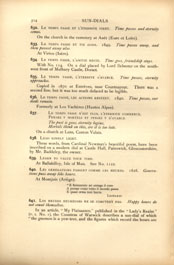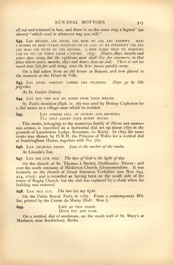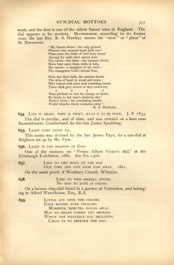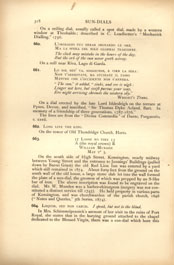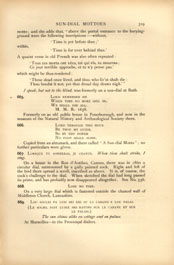Sun-Dial Mottoes (continued.)
| 534. | J'ATAN L'EURE (sic) (J'ATTENDS L'HEURE). I await the hour. Seen in Dauphiné. Another curiously spelt version of the same motto was read on the Château of the Cité de Carcassonne, Je attends levre. |
| 535. | J'AVANCE. I go forward. On a horizontal dial in the garden at Hall Place, Berks. It is the family motto of Sir Gilbert East, Bart., the owner, whose crest is a horse passant, sable. The same inscription has been placed on the gnomon of a horizontal dial lately put up at Lyndhurst, Hants. The arms of the owner, Mr. Penton, are engraved on the plate, and the maker's name, F. Barker. |
| 536. |
JE CHANTERAI At Noves (Bouches du Rhône), a cock and hen are depicted on the dial, and chanticleer speaks. Cp. No. 667. |
| 537. | JE CHERCHE MIDI. I seek noon. Inscribed below a dial in the Rue du Cherche Midi, Paris. The street has borne this name since 1595, and probably owes it to the sun-dial, which now is on a stone slab in the wall of a house, with a bas-relief of a man tracing a sun-dial from which the noon-day line and figure XII are absent, and which bears the words "au cherche midi." Beside these is a child representing either the little god Cupid, or the Genius of Day. The reference, of course, is to the Italian hours, which were counted from sunset to sunset, and when these were in common use the phrase "chercher midi à quatorze heures," would be readily understood. It signified to waste time in a vain folly, to seek for the impossible – for though the hour of noon might fall at sixteen, seventeen, or eighteen o'clock, according to the hour of sunset and the time of year, it could never in these latitudes be at fourteen. There is a story told of Voltaire that in passing through a village where the inhabitants were putting up a sun-dial, he was intreated to give them a motto, and accordingly wrote the following impromptu: "Vous qui venez dans ces demeures, |
| 538. | JE DONNE LA LUMIÈRE À LA GLOIRE DE DIEU. I give light to the glory of God. With No. 595, formerly in the garden of the convent of Capuchin nuns in the Place Vendôme, Paris. |
| 539. | J'EN VOIS PASSER PLUS D'UN. I see more than one pass away. On the cemetery chapel, Mirepoix (Ariège). |
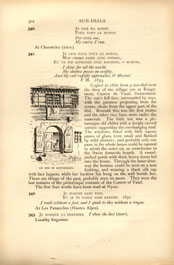
[Full Image]
AN INN IN ROUGEMONT.
| 540. | JE FAÏS MA RONDE At Charnècles (Isère). |
| 541. |
JE LUIS POUR TOUT LE MONDE, Copied in 1866 from a sun-dial over the door of the village inn at Rougemont, Canton de Vaud, Switzerland. The sun's full face, surrounded by rays, with the gnomon projecting from the centre, shone from the upper part of the dial. Beneath this was the first motto, and the other two lines were under the numerals. The little inn was a picturesque old châlet with a deeply carved cornice supporting the overhanging roof. The windows, fitted with little square panes of glass, were small and flanked by solid shutters; and probably only one pane in the whole house could be opened to admit the outer air, so unwelcome to the Swiss domestic hearth. A round-arched porch with thick heavy doors led into the house. Through the inner doorway the hostess could be seen on a seat knitting, and wearing a black silk cap with lace lappets, while her beehive hat hung on the wall beside her. These are things of the past, probably seen no more. They were the last remains of the picturesque costume of the Canton of Vaud. The first four words have been read at Nyon. |
| 542. |
JE MARCHE SANS PIED, I walk without a foot, and I speak to thee without a tongue. At Les Pananches (Hautes Alpes). |
| 543. | JE MARQUE LA DERNIÈRE. I show the last (hour). Locality forgotton. |
| 544. | JE MARQUE LE TEMPS QUE VOUS PERDIEZ. 1860. I note the time that you waste. On the Château of La Brillane (Basses Alpes). |
| 545. | JE MARQUE LE TEMPS VRAI, This is inscribed above a dial on a house at Pau, opposite the Halles. Beneath it are the words: "Les horologes et les Cadrans indiquent à quelques secondes près la même heure le 25 xbre, le 15 Avril, le 25 juin, et le Iière 7bre. |
| 546. |
JE MESURE LE TEMPS, IMAGE MOBILE I measure time, a moving image of motionless eternity. At Ville Vieille, Queyras. Also at St. Véran (Hautes Alpes), signed Z. G. F. (Zarbula), and having a picture of a toucan above on the right, and a fly-catcher on the left. |
| 547. |
JE NE PUIS RIEN SANS LE SOLEIL, Without the sun I am useless, but when he shines I have no equal. At Les Cabanes, near Cordes (Tarn). |
| 548. | JE NE SAURAIT TROMPER. In the court of Evêchè, Angoulême. |
| 549. | JE PARLE SANS DIRE MOT. 1885. I speak without saying a word. On a house in the Place, Puy-St. Pierre (Hautes Alpes). |
| 550. | JE REGLE ET CHANGE PAR MON COURS Once at Boulogne. |
| 551. | JE SUIS JUSTE, SOYEZ LE AUSSI. 1811. I am true, be ye true likewise. This inscription is more modern than the date. The dial is near the Grande Séminaire, Moutiers, Savoy. The first half of the motto is on the Curé's house, Brides-les-Bains, Savoy. |
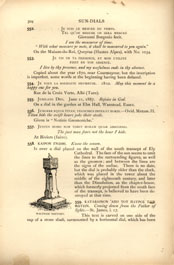
[Full Image]
WALTHAM RECTORY.
| 552. |
JE SUIS LE MESURE DE TEMPS. On the Maison-du-Roi, Queyras (Hautes Alpes), with No. 1034. |
| 553. |
JE VIS DE TA PRÉSENCE, ET MON UTILITÉ Copied about the year 1870, near Courmayeur, but the inscription is imperfect, some words at the beginning having been defaced. |
| 554. | JE VOUS LA SOUHAITE HEUREUSE. 1810. May this moment be a happy one for you. Rue de la Croix Verte, Albi (Tarn). |
| 555. | JUBILATE DEO. June 21, 1887. Rejoice in God. On a dial in the garden at Elm Hall, Wanstead, Essex. |
| 556. | JUNGERE EQUOS TITAN, VELOCIBUS IMPERAT HORIS. – Ovid, Metam. II. Titan bids the swift hours yoke their steeds. Given in "Notizie Gnomoniche." |
| 557. | JUSTUS HOMO NON TIMET HORAM QUAM ABSCONDO. The just man fears not the hour I hide. At Biviers (Isère). |
| 558. | ΚΑΙΡΟΝ ΓΝΩΘΙ. Know the season. Is over a dial placed on the wall of the south transept of Ely Cathedral. The face of the sun seems to emit the lines to the surrounding figures, as well as the gnomon; and between the lines are the signs of the zodiac. There is no date, but the dial is probably older than the clock, which was placed in the tower about the middle of the eighteenth century, andlater than the Dissolution, as the chapter-house, which formerly projected from the south face of the transept, is believed to have been destroyed at that time. |
| 559. | ΚΑΤΑBΑΙΝΟΝ ᾽ΑΠΟ ΤΟϒ ΠΑΤΡΟΣ ΤΟΝ ΦΩΤΩΝ. Coming down from the Father of lights. – St. James, i. 17. This text is carved on one side of the cap of a stone shaft, surmounted by a horizontal dial, which has been |
| set up by the Rev. W. Tuckwell in his garden at Waltham Rectory, Lincolnshire. On the three remaining sides of the cap are cut: (1) The arms of Winchester College, with its motto "Manners makyth man"; (2) A line from the Æneid, Book VI., 545 (See No. 293); and (3) A shield bearing a cross and crown, and the legend "Servire regnare," – a device and motto which Mr. Tuckwell has adopted as his own. The device was copied from a seal dug up at Osney Abbey. | |
| 560. | L'AMBITION EST LA PERTE DE L'HONNEUR. 1825. Ambition is the ruin of honour. At La Bez (Hautes Alpes). |
| 561. | LA CHARITÉ NOUS UNIT. Love unites us. On the former convent of the Minimes, Vitry le Français. 1883. |
| 562. | LA DERNIÈRE DÉCIDE DE TOUTES. 1792. All's well that ends well. On the church at Les Claux, Vallouise (Hautes Alpes). |
| 563. | LA DERNIÈRE EST CACHÉE. The last is hidden. Châteauneuf de Gadagne (Vaucluse). |
| 564. | LA DERNIÈRE FAIT LA COMPTE. Reckoning comes at the last. On a house, Route de Versailles, Sèvres. |
| 565. | LA DERNIÈRE PEUT-ÊTRE POUR TOI. Perhaps the last (hour) for thee. At Fure (Isère). |
| 566. | L'ÉTERNITÉ DÉPEND D'UNE HEURE. Eternity hangs upon an hour. At Annecy (Haute Savoie). |
| 567. | LA GLOIRE DU MONDE, PASSE COMME L'OMBRE. 19 Juillet, 1632. The glory of the world passeth away like a shadow. On the belfry, Le Pin (Isère). |
| 568. | L'HEURE D'AIMER DIEU. 1691. Now is the time for loving God. On a church at Poliénas (Isère). |
| 569. | L'HEURE D'ÉLEVER SON CŒUR À DIEU. 18 Juin, 1791. Now is the time to lift our hearts to God. On a church at Poliénas. (Isère). |
| 570. | L'HEURE DHOBEI AV ROI (sic). 1720. Now is the time to obey the King. At Beaucroissant (Isère), above a dolphin's head surrounded by fleurs-de-lys. |
| 571. | L'HEURE DU TRAVAIL. 1796. L'An V. (of the Republic). Now is the time for work. At Izeaux (Isère). |
| 572. | L'HEURE EST À DIEU, On a sun-dial, thirty feet in diameter, at Cassiobury, Herts, the letters being made in box on a double gravel ring in the turf, designed by Lady Essex. |
| 573. | L'HEURE FUIT, L'ETERNITÉ APPROCHE. The hour flies, eternity draws near. At Réaumont (Isère). |
| 574. | L'HEURE NOVS DÉROBE LE JOUR. 1703. The hour steals away the day. Hameau de la Combe, near Rovon (Isère). |
| 575. | L'HEURE PACE (sic) ET TOI AUSSI. 1776. Time passes, and thou dost the same. At La Folatière (Isère). |
| 576. | L'HEURE PASSE COMME LE TEMPS. 1847. The hour passes as doth Time. At St. Marcellin (Isère). |
| 577. | L'HEURE QU'ON NE PENSE PAS. 1809. The hour one least expects. At Seyssins (Isère) |
| 578. | L'HEURE QUE TU CHERCHES TE CONDUIT À LA MORT. The hour that thou lookest for leads thee to death. At Les Orres, near Embrun (Hautes Alpes). |
| 579. | L'HEURE QUI SUIT N'EST PAS À VOUS. The hour which follows belongs not to you. On the belfry of St. Gervais. When the dial was finished the painter stepped back to look at his work, the scaffolding shook, he fell and was killed on the spot. (See "La Cloche," by M. Blavignac.) |
| 580. | L'HEURE VA NAÎTRE; ELLE EST; ELLE EST PASSÉE. 1868. The hour is about to be; it is;it passes away. On a house at Les Queyrelles (Hautes Alpes). The dial is ornamented with paintings of a cock and a pot of flowers. |
| 581. |
LA LUMIÈRE EST MA RÈGLE, At Chamaloc (Drôme). |
| 582. | LA MORT N'A POINT D'HEURE FIXE. 1812. Death has no fixed time. On the curé's house, Eybens (Isère). |
| 583. | LA MORTE ANNUNZIO IN DISTINGUENDO IL GIORNO (Preti). Dividing hour from hour a messenger of death am I. Given in "Notizie Gnomoniche." |
| 584. |
L'OMBRA CHE VEDI O PASSAGIER DA VELOCISSIME The shadow's hours, traveller, swiftly speed, On a house in a village near the Lago di Garda. The words Soli, soli, soli, are written between the numerals. |
| 585. |
L'OMBRA È FIGURA DELLA TUA LABIL VITA, On a house by the Grand Canal, Venice. "Men desire thousands of days and wish to live long here; let them rather despise thousands of days, and desire that one which hath neither dawn or darkening, to which no yesterday give place, which yields to no to-morrow." – S. Augustine, quoted by Archbishop Leighton. |
| 586. |
L'OMBRE FUIT ET REVIENT, ET DANS SON COURS ÉGAL |
On a dial for a college (school), exhibited in the Conservatoire des Arts et des Métiers, Paris. It is the same as the rendering given by M. Dubois, in 1806, of the Latin motto now on the Lycée at Rouen. |
|
| 587. | L'OMBRE FUIT, LA MORT APPROCHE. 1825. The shadow flies, death draws nigh. At Crest (Drôme). |
| 588. | L'OMBRE PASSE ET REPASSE, In a garden not far from Falaise, Normandy. |
| 589. | L'ORA CHE L'OMBRA MIA FEDEL TI ADDITA, On a house at Murano, near Venice, with No. 43. |
| 590. | LA PAIX RAMÈNE L'ABONDANCE. 1815. Peace restores plenty. At St. Savin (Isère). |
| 591. | LA VERTU EXCEPTÉE TOUT PASSE COMME L'OMBRE. All things, save virtue, pass away like a shadow. At Roybon (Isère) |
| 592. | LA VIE AINSI QUE L'OMBRE SE PASSE EN PEU D'HEURES. Life, like the shadow, passes away in a few hours. No place assigned. |
| 593. | LA VIE EST COMME L'OMBRE, On a house at Bourges, with No. 1177. |
| 594. | LA VIE N'EST QU'UN SOUPIR, On the chapel of St. Jacques, Hameau de Bellentre (Savoy). |
| 595. | LA VIE PASSE COMME L'OMBRE. Life passes like the shadow. At Quaix (Isère); at St. Egrève; and formerly, with No. 538, in the garden of the Capuchin Nuns' Convent, Place Vendôme, Paris. With slight variations it may be also read at La Saxe, near Courmayeur; and La Cachourie, Savoy. |
| 596. | LA VITA FUGGE E NON S'ARRESTA UN' ORA (Petrarch.) Life flies apace with not an hour's delay. Given in "Notizie Gnomoniche." |
| 597. | LABENTE TEMPORE FUTURUM COGITA. As time glides think on the future. On the University of Padua. |
| 598. | LABITUR ET LABETUR. It glides, and will glide away. On a dial over the church porch at Leake, Yorks; and at the Convent of Cimiez, Nice (see Nos. 233, 1111, 1463, 1475, 1618). The words are from Horace, Epist. i. 2, 43. The simile is that of the countryman who when he comes to the river waits stolidly for the water to flow away so that he may be able to cross to other side. "Qui recte vivendi prorogat horam, Ovid has a similar passage: "Eunt anni more fluentis aquae. Dr. Young has adopted a like metaphor in his "Night Thoughts." "Life glides away, Lorenzo, like a brook; |
| 599. | LABITUR OCCULTE, FALLITQUE VOLUBILE TEMPUS. On-rolling time glides by silently and unperceived. On a house built in 1889, at Civiasco, near Varallo. At Colonel Helyar's very interesting house, Poundisford, near Taunton, there is an old dial with an inscription so nearly obliterated that only Labitur occ – can now be read. Probably it originally bore the whole of the motto above. The line is slightly altered from Ovid, Eleg. i.: "Labitur occulte, fallitque volubilis ætas, |
| 600. | LABOR ET GLORIA VITA FUIT, MORS REQUIES. Life was work and honour, death is repose. Sent by the Hon. Mrs. R. C. Boyle. |
| 601. | LABOR IPSE VOLUPTAS. Toil itself is pleasure. With initials and date C. H. 1718, on the Old Hall, Bransby, near Saxilby. The kitchen buildings, on which the dial is placed, are all that now remain of the original hall. |
| 602. | LABORA DUM LUCET. Work while it is light. At Les Avenières (Isère). |
| 603. | LABORARE EST ORARE. To work is to pray. Seen on an outhouse near Nice in 1860, by Mr. Cowden Clarke. |
| 604. | LABUNTUR ANNI. The years glide away. On Burnham Church, Somerset. See No. 780. |
| 605. | LAETA ROGO NITEANT DIVINA ILLUMINA PHOEBI Contributed by Viscount de Vesci. Locality not known. |
| 606. | LAS KEINE STUND FURUBER GHAN On an ivory portable compass dial in the National Museum at Munich, with No. 1016. |
| 607. | LATET ULTIMA. The last (hour) is hidden. On a dial in the garden at Bispham Hall, Lancashire; and with date, 1793, on a châlet at Alagna. Compare No. 1475. |
| 608. | L'AMOUR ET LA JEUNESSE Love and youth are but day-dreams, which pass away like the sunshine and the shadow. In a village near Courmayeur. |
| 609. |
I . H . S |
vn . tribvnal . den . havt . pechevr . y . penset . An inscription engraved on the four sides of a slate dial, formerly at Brulon (Sarthe), now at Le Mans. The verses should be read thus: L'arrêt en est donné, il faut que l'homme meurt, The last line has been broken off. The decree hath gone forth that man must die |
|
| 610. | LE CIEL EST MA PATRIE. Heaven is my country. On the church at Fortville, near Briançon. |
| 611. | LE CIEL EST MA RÈGLE. Heaven is my ruler. At Florence, on the studio of Signor Gelli, artist. Also at Romans (Drôme), dated 1848; and at Fontenay aux Roses (Seine). |
| 612. | LE DO BUONE, LE DO MALE. I give good (seasons), I give bad (seasons). At La Versine, near Chantilly, on the house of the Comte de de St. Simon. |
| 613. | L'ÉTERNEL A DIT : LES MONTS NE POURRONT T'ARRÊTER DANS TA COURSE. The Eternal hath spoken : the mountains shall not hinder thee in thy course. This was designed about 1850, and was till lately on a house at Les Queyrelles (Hautes Alpes). |
| 614. | L'HOMME DÉCLINE COMME L'OMBRE. Man declines like the shadow. At Maussane. |
| 615. | L'HOMME EST SEMBLABLE À LA VANITÉ ; SES JOURS SONT COMME UN OMBRE QUI PASSE. Man is like to vanity: his days are as a shadow that passeth away. Psalm cxliv. 4 (Bible version). On a dial above the porch of St. Brelade's Church, Jersey. There is a free rendering of the same text on an eighteenth century dial which is mounted on an antique marble pedestal in a garden, Rue du Collège, St. Girons, and No. 148 is also engraved upon it. |
| 616. |
L'ŒIL ÉCLATANT DE LA NATURE At the Hôtel Garçon Frères, Peisey (Savoy). |
| 617. | L'ORE DEL DÌ SON SEI VOLTE QUATTRO, Given in "Notizie Gnomoniche. |
| 618. | L'ORE DEL VIVER TUO INCERTE E CORTE, Given in "Notizie Gnomoniche." |
| 619. | L'ORE NON SEGNO SE MI MANCA L'OMBRA, Given in "Notizie Gnomoniche". |
| 620. | LE PLAISIR LES ABRÈGE. 1790. Pleasure shortens them. At Izeaux (Isère). |
| 621. | LE PRÉSENT N'EST JAMAIS NOTRE BUT. This is not your Rest. On the church at San Martino, parish of Casaleggio, near Novi, Piedment. |
||||
| 622. | LE SOLEIL ET LA LUNE ÉCLAIRENT TOUT LE MONDE. Aris. Aubergiste. The sun and moon give light to all. On the front of an inn at Betharram. |
||||
| 623. | LE SOLEIL FUIT ET L'OMBRE RESTE. The sun flies and the shadow stays. In the Rue Neuve, Aime (Savoy). |
||||
| 624. |
Pont de Cervières (Hautes Alpes). |
||||
| 625. | LE SOLEIL LUIT POUR TOUT LE MONDE. The sun shines for all. On a cabaret at La Vachette (Hautes Alpes). This is not an infrequent motto for cabarets, and once figured on the celebrated cabaret de Ramponneau aux Porcherons, Paris. It is also found at Ste. Euphèmie (Drôme). |
||||
| 626. | LE SOLEIL SE LÈVE POUR TOUT LE MONDE. The sun rises for all. On the "Auberge du Mouton Chéri," Rue de Cartres, Toulouse. |
||||
| 627. | LE TEMPS C'EST DE L'OR. 1703. Time is golden. Formerly at Noippy (Moselle). |
||||
| 628. | LE TEMPS FUIT EMPORTANT LES HEURES SUR LES AILES, Suggested for a Palais de Justice. From a collection made by M. Dubois, 1806 (Rom. 1881). |
||||
| 629. | LE TEMPS FUIT, L'ÉTERNITÉ S'AVANCE. Time flies, eternity draws near. Near the source of the Isère, at Tignes (Savoy), partly defaced. |
||||
| 630. |
At the Ecole des Frères, Moissac (Tarn et Garonne); and at Le Périer (Isère). |
||||
| 631. | LE TEMPS MÈNE À L'ÉTERNITÉ, QUI EN SAIT Time leads to eternity, he who knows how to use the one well will make the other happy for himself. At Villard St. Pancrace (Hautes Alpes). |
| 632. | LE TEMPS PASSE ET L'ÉTERNITÉ VIENT. Time passes and eternity comes. On the church in the cemetery at Anêt (Eure et Loire). |
| 633. | LE TEMPS PASSE ET TOI AUSSI. 1849. Time passes away, and thou passest away also. At Virieu (Isère). |
| 634. | LE TEMPS PASSE, L'AMITIÉ RESTE. Time goes, friendship stays. With No. 114. On a dial placed by Lord Ilchester on the southwest front of Melbury Castle, Dorset. |
| 635. | LE TEMPS PASSE, L'ETERNITÉ S'AVANCE. Time passes, eternity approaches. Copied in 1870 at Entrèves, near Courmayeur. There was a second line, but it was too much defaced to be legible. |
| 636. | LE TEMPS PASSE, LES ACTIONS RESTENT. 1840. Time passes, our deeds remain. Formerly at Les Vachères (Hautes Alpes). |
| 637. | LE TEMPS PASSÉ N'EST PLUS, L'ÉTERNITÉ COMMENCE, On a church at Lens, Canton Valais. |
| 638. | LEAD KINDLY LIGHT. These words, from Cardinal Newman's beautiful poem, have been inscribed on a modern dial at Castle Hall, Painswick, Gloucestershire, by Mr. Baddeley, the owner. |
| 639. | LEARN TO VALUE YOUR TIME. At Ballakilley, Isle of Man. See No. 1122. |
| 640. | LES GÉNÉRATIONS PASSENT COMME LES HEURES. 1828. Generations pass away like hours. At Montjoie (Ariège). "E fieramente mi stringe il core |
| 641. | LES HEURES HEUREUSES NE SE COMPTENT PAS. Happy hours do not count themselves. In an article, "My Plaisaunce," published in the "Lady's Realm" (V. I. No. I), the Countess of Warwick describes a sun-dial of which "the gnomon is a yew-tree and the figures which record the hours are |
| all cut and trimmed in box, and there is on the outer ring a legend" (as above) "which read in whatever way you will." | |
| 642. | LES HEVRES, LES IOVRS, LES MOIS ET LES ANS PASSENT. MAIS L'HOMME DE BIEN VIVRAS TOUJOVRS EN CE LIEV OV NE FINISSENT LES ANS LES MOIS LES IOVRS ET LES HEVRES. A BIEN FAIRE TROP NE DEMEVRE CAR EN PEV DE TEMPS PASSE L'HEVRE. 1657. Hours, days, months and years pass away, but the righteous man shall live for evermore, in that place where years, months, days and hours have no end. There is not too much time left for well doing, since the hour passes quickly away. On a dial taken from an old house at Beaune, and now placed in the museum at the Hôtel de Ville. |
| 643. | LES JOURS PASSENT COMME LES PÉLERINS. Days go by like pilgrims. At St. Geoire (Isère). |
| 644. | LET NOT THE SUN GO DOWN UPON YOUR WRATH. St. Paul's monition (Eph. iv. 26) was used by Bishop Copleston for a dial motto in a village near which he resided. |
| 645. | LET OTHERS TELL OF STORMS AND SHOWERS, This motto, belonging to the numerous family of Horas non numero nisi serenas, is inscribed on a horizontal dial set up about 1870 in the grounds of Lansdowne Lodge, Kenmare, co. Kerry. In 1895 the same motto was chosen by H. R. H. the Princess of Wales for a vertical dial at Sandringham House, together with No. 767. |
| 646. | LEX ANCHORA REGNI. Law is the anchor of the realm. At Lincoln's Inn. |
| 647. | LEX DEI LUX DIEI. The law of God is the light of day. On the church of St. Thomas à Becket, Dodbrooke, Devon; and over the south entrance of Mickleton Church, Gloucestershire. It was formerly on the church of Great Smeaton, Yorkshire (see Nos. 693, 914, 1020); and is recorded as having been on the south side of the tower of Rugby Church, but the dial was replaced by a clock when the building was restored. |
| 648. | LEX MEA LUX. The law (is) my light. On the Palais Royal, Paris, in 1787. From a contemporary MS. list, printed by the Comte du Marsy (Bull:Mon:). |
| 649. | LIFE AS THIS SHADE On a vertical dial of sandstone, on the south wall of St. Mary's at Marlston, near Bucklebury, Berks. |
|
| 650. | LIFE'S BUT A FLEETING SHADOW. At Langton Matravers, Dorset. A slightly different version, LIFE PASSETH AS A SHADOW, was formerly on the nave of Cardington Church, Bedford, with date, circa 1780, and initials "C. W." The dial was taken down during the restoration of the church, but is being repaired and re-adjusted by Mr. E. C. Middleton, and will be replaced on the south wall of the building."C. W." was probably a member of the Whitehead family who own the adjoining estate of Southill. The present head of the family has represented Bedford for many years in Parliament. |
| 651. | LIFE'S BUT A SHADOE, On the church of All Saints, Winkleigh, Devon. |
| 652. | LIFE'S BUT A WALKING SHADOW. 1769. From "Macbeth," Act V., Scene 5, is on an erect south dial on an old house in the Close, Salisbury, formerly inhabited by James Harris, the author of "Hermes," a Salisbury man, who died in 1780, and who may have erected and inscribed the dial. The same motto is on Woodborough Manor House, Wilts, and on a vertical dial on the stables at Arbury, Warwickshire – the "Cheveril Manor" described by George Eliot. |
| 653. | LIFE IS LIKE A SHADOW. Over the porch of the fine old church of St. John the Baptist, Morwenstow, Cornwall, which dates its foundation from the ninth or tenth century. The entrance door to the nave is very good Norman |
work, and the font is one of the oldest Saxon ones in England. The dial appears to be modern. Morwenstow, according to its former vicar, the late Rev. R. S. Hawker, means the "stow" or "place" pf St. Morwenna.
|
|
| 654. | LIFE IS SHORT, TIME IS SWIFT, MUCH IS TO BE DONE. J. S. 1833. The dial is circular, and of slate, and was erected on a barn near Bassenthwaite, Cumberland, by the late James Spedding. |
| 655. | LIGHT COME LIGHT GO. This motto was devised by the late James Payn, for a sun-dial at Brighton set up by Mr. Pym. |
| 656. | LIGHT IS THE SHADOW OF GOD. One of the mottoes on "Prince Albert Victor's dial," at the Edinburgh Exhibition, 1886. See No. 1306. |
| 657. | LIKE TO THE HOUR OF THE DAY On the south porch of Westbury Church, Wiltshire. |
| 658. | LIKE TO THIS SIRKELL ROUND On a bronze ring-dial found in a garden at Yattendon, and belonging to Alfred Waterhouse, Esq., R. A. |
| 659. | LITTLE SUN UPON THE CEILING |
On a ceiling dial, usually called a spot dial, made by a western window at Theobalds; described in C. Leadbetter's "Mechanick Dialling," 1756. |
|
| 660. | L'OROLOGIO PUO ERRAR SEGNANDO LE ORE, On a mill near Riva, Lago di Garda. |
| 661. | LO SOL SEN' VA, SOGGIUNSE, E VIEN LA SERA: On a dial erected by the late Lord Iddesleigh on the terrace at Pynes, Devon, and inscribed, "Sir Thomas Dyke Acland, Bart. In memory of a friendship of three generations, 1787-1879." The lines are from the "Divina Commedia: of Dante, Purgatorio, c. xxvii. |
| 662. | LONG LIVE THE KING. On the tower of Old Thundridge Church, Herts. |
| 663. |
17 LOOSE NO TIME 13 On the south side of High Street, Kensington, nearly midway between Young Street and the entrance to Jennings' Buildings (pulled down by Baron Grant) the old Red Lion Inn was entered by a yard which still remained in 1874. About forty feet from the ground on the south wall of the old house, a large stone slab let into the wall formed the plate of a sun-dial, the gnomon of which was propped by an S-like bar of iron. The above inscription was found to be engraved on the dial. Mr. W. Munden was a barber-chirurgeon (surgery was not constituted a distinct service till 1745). He held property in various parts of Kensington, and was churchwarden of the parish church, 1698 ("Notes and Queries," 5th Series, 1874). |
| 664. | LOQUOR, SED NON CAECIS. I speak, but not to the blind. In Mrs. Schimmelpennick's account of her visit to the ruins of Port Royal, she states that in the burying ground attached to the chapel dedicated to the Blessed Virgin, there was a sun-dial which bore this |
motto; and she adds that, "above the portal entrance to the burying-ground were the following inscriptions : – without, 'Time is yet before thee;' within, 'Time is for ever behind thee.' A quaint verse in old French was also often repeated: 'Tous ces morts ont vécu, toi qui vis, tu mourras; which might be thus rendered: 'These dead once lived, and thou who liv'st shalt die: I speak, but not to the blind, was formerly on a sun-dial at Bath. |
|
| 665. | LORD REMEMBER ME Formerly on an old public house in Peterborough, and now in the museum of the Natural History and Archæological Society there. |
| 666. | LORD THROUGH THIS HOUR Copied from an almanack, and there called "A Sun-dial Motto"; no further particulars were given. |
| 667. | LORSQUE TU SONNERAS, JE CHANTE. When thou shalt strike, I sing. On a house in the Rue d'Antibes, Cannes, there was in 1860 a circular dial, surmounted by a gaily painted cock. Right and left of the bird there spread a scroll, inscribed as above. It is, of course, the cock's challenge to the dial. When sketched the dial had long passed its prime, and has probably now disappeared altogether. See No. 536. |
| 668. | LOSE NO TIME. On a very large dial which is fastened outside the chancel wall of Middleton Church, Lancashire. |
| 669. |
LOU SOULEI FA LUSI SEI REI SU LA CABANO E LOU PALAI. At Marseilles – in the Provençal dialect. |
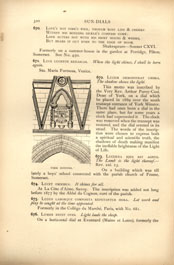
[Full Image]
YORK MINSTER.
| 670. | LOVE'S NOT TIME'S FOOL, Formerly on a summer-house in the garden at Perridge, Pilton, Somerset. See No. 450. |
| 671. | LUCE LUCENTE RENASCAR. When the light shines, I shall be born again. Sta. Maria Formosa, Venice. |
| 672. | LUCEM DEMONSTRAT UMBRA. The shadow shows the light. This motto was inscribed by the Very Rev. Arthur Purey-Cust, Dean of York, on a dial which he placed in 1889 over the south transept entrance of York Minster. There had once been a dial in the same place, but for some years a clock had superseded it. The clock was removed when the transept was restored, and the dial erected in its stead. The words of the inscription were chosen to express both a spiritual and scientific truth, the shadows of death making manifest the ineffable brightness of the Light of Life. |
| 673. | LUCERNA EJUS EST AGNUS. The lamb is the light thereof. – Rev. xxi. 23. On a building which was till lately a boy's school connected with the parish church of Frome, Somerset. |
| 674. | LUCET OMNIBUS. It shines for all. At La Côte d'Aime, Savoy. The inscription was added not long before 1877 by the Abbé du Cognon, curé of the parish. |
| 675. | LUDUS LABORQUE COMPOSITA REPETANTUR HORA. Let work and play be sought at the time appointed. Formerly in the Collège du Marché, Paris, with No. 681. |
| 676. | LUMEN DUCIT OVES. Light leads the sheep. On a horizontal dial at Évantard (Maine et Loire), formerly the |
